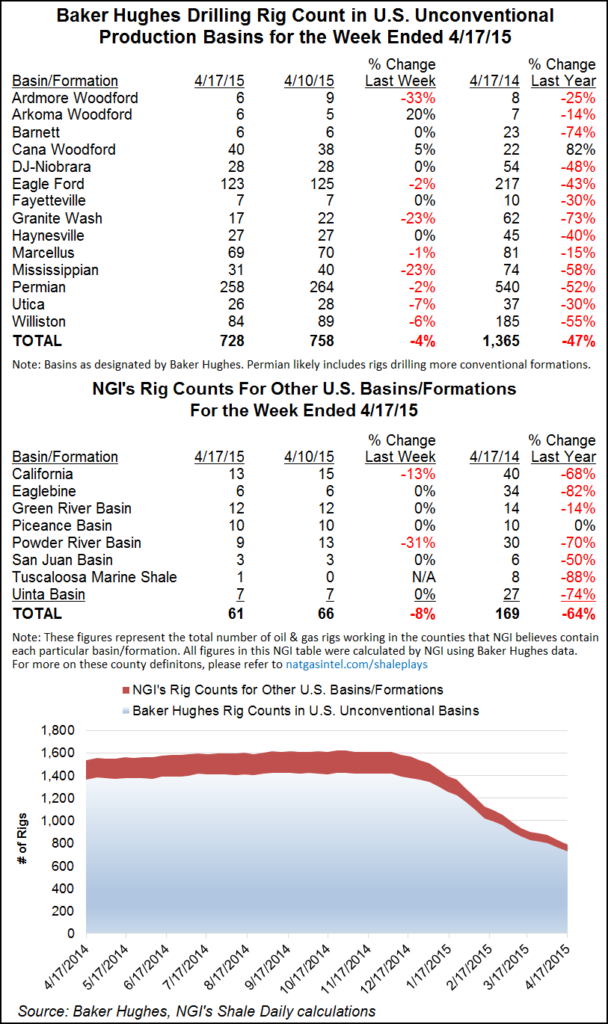NGI Archives | NGI All News Access
BHI U.S. Rig Count Steady as Permian, Marcellus Activity Rises
Having enjoyed consistent growth since 2016, the U.S. rig count has leveled off in recent weeks, a trend that continued for the week ended Friday as Baker Hughes Inc.’s (BHI) domestic tally increased by two units overall, including gains in the Marcellus Shale and Permian Basin.

The United States added three oil-directed rigs and dropped one natural gas-directed rig for the week to end at 1,048, up from 958 a year ago but only slightly above the 1,045 active domestic rigs reported for the week ended May 11. Since May 11, the share of total U.S. rigs drilling for oil has increased to 82.2% from 80.8%, while the share of gas-directed rigs has slipped from 19.0% to 17.7%, BHI data show.
For the week ended Friday, three U.S. directional units exited the patch, while five vertical units returned. Total land rigs increased by six, while three rigs departed inland waters, according to BHI. The Gulf of Mexico dropped two rigs to end the week at 15 active units, down from 23 a year ago.
Canada added 12 rigs — all oil-directed — to grow its tally to 223.
The combined North American rig count finished the week at 1,271, up from 1,178 at this time last year.
Among plays, the Permian led gainers for the week, adding four rigs to reach 480 in total, outpacing its year-ago tally by just above 100 rigs. Other gainers included the Marcellus, which added three rigs to reach 55 from 46 a year ago, and the Granite Wash, which saw two rigs return to end at 14, down one from a year ago. The Williston Basin added one rig for the week, while the Eagle Ford, Haynesville and Utica shales each saw one rig depart.
Among states, despite the uptick in Permian activity, Texas finished with a net gain of only one rig, while New Mexico also saw one rig return to action. Pennsylvania added two rigs for the week, while Alaska, Kansas, North Dakota and West Virginia added one each.
Louisiana posted the largest weekly decline among states, losing four rigs to end at 52 from 72 a year ago. Ohio and Oklahoma each dropped one rig.
As 2Q2018 earnings season rolls on, many in the industry are watching for any signs of Permian takeaway constraints impacting growth out of the U.S. onshore’s most active play. Exploration and production (E&P) companies that have worked in the Permian for months have been sending signals that pipelines are filling up, which could hinder growth plans, i.e. capital expenditures (capex).
Several oilfield service operators that serve the U.S. onshore already said they have concerns about the lack of takeaway potential. Still, E&Ps for now are supported by “macro tailwinds, leaving prices above budgeted levels offset by well documented infrastructure constraints in the Permian,” said Wells Fargo LLC senior analyst Gordon Douthat.
Chevron Corp. executives made clear on Friday that any Permian pipeline constraints would be resolved in short order, saying such limitations are unlikely to slow down activity as it moves to export more oil overseas and expand midstream operations to take care of natural gas and liquids.
The San Ramon, CA-based supermajor is running 19 rigs in the Permian today and so far has suffered no supply shortages, upstream chief Jay Johnson said during a conference call to discuss second quarter results.
“Chevron has secured firm transport capacity at competitive rates to move the equivalent of nearly all of our forecasted 2018 and 2019 operated and” joint venture “take-in-kind-oil production to multiple markets, including the U.S. Gulf Coast,” Johnson said. Because of the contracted arrangements, production “is not materially exposed to the Midland basis differential.” Pipeline takeaway capacity and production “don’t always move in perfect lockstep. There will be periods of tightness and length.”
© 2024 Natural Gas Intelligence. All rights reserved.
ISSN © 2577-9877 | ISSN © 2158-8023 |
